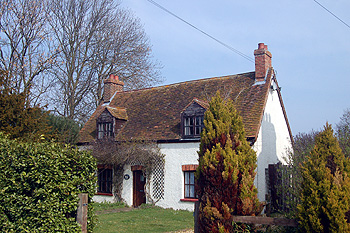
21 High Road March 2011
21 High Road was listed by English Heritage in December 1994 as Grade II, of special interest. The property dates from the early to mid 18th century. It is a timber framed building with pebble-dashed rendering and a tiled roof. A fireplace in the north gable has an adjacent bread oven.
We are fortunate that three surveys of the parish of Cardington from the late 18th century survive. The first of these was undertaken in 1782 by James Lilburne. He was the parish schoolmaster and later agent for Samuel Whitbread, who owned large estates in the parish and also the sole Enclosure Commissioner for the parish. He produced a list of all the inhabitants of the parish arranged by house and hamlet [P38/28/1]. This was published, with extensive analysis by County Archaeologist David Baker in 1973 as Bedfordshire Historical Record Society Volume 52.
Since publication a second list has been found [P38/28/2]. It carries revisions up to the year 1789. Sadly neither of these surveys includes a map. Finally, in 1794 Lilburne produced another survey [W2/6/1-3] and this one had a map with a key showing where each house was. One can use this to plot the houses of the previous surveys and this work was carried out by John Wood of Bedfordshire County Council’s Conservation Section in October 1982 [CRT130Cardington29].
The 1782 survey [P38/28/1/2] states that 21 High Road was in the occupation of Elizabeth Saunders, née Gray, a 34 year old widow who had been born in Southill and spun linen. Her children were: Joseph, aged 7, schooled at the expense of John Howard; Judith, aged 5, schooled at the expense of Samuel Whitbread; Elizabeth aged 4 and Sarah aged 2. The three younger children were taught to sing. Elizabeth was willing for herself and her children to be inoculated against smallpox if other in the village were also. The survey of 1794 [W2/6/1-3] records Charles Savage living at the premises.
Tithes were, originally, a tenth of one’s household produce, usually an arable crop such as wheat or barley but possibly livestock or manufactured produce such as shoes, given to support the local priest. They were divided into great and little tithes. Great tithes consisted of grain or large animals such as cattle. Little tithes were fruit, vegetables or other small crops and smaller farm animals such as poultry. By the 19th century this archaic practice had long been replaced by monetary tithes. The Tithe Commutation Act of 1836 finally made it compulsory to replace these archaic tithes with monetary payments. The payment was calculated on the seven year average of prices for the particular commodity derived from the land in question and was worked out by the parties involved – parson, landowners or tenants if the land was not owner-occupied. The parish of Cardington, including Cotton End, was assessed for tithes in 1840 [AT9/1]. At that date 21 High Road was owned by Emery Cranfield and occupied by Jonathan Cranfield. It was listed as Savages Home Close of pasture and a homestead (the cottage). The land comprised 4 acres, 3 roods, 1 pole and 4 shillings was payable to the vicar and 1/3 to the impropriator – in other words the owner of the advowson.
The Rating and Valuation Act 1925 specified that every building and piece of land in the country was to be assessed to determine its rateable value. Eastcotts, like most of the county, was assessed in 1927 and the valuer visiting 21 High Road [DV1/C286/35] found it owned by Mrs Izzard and occupied by J. R. Izzard rent free.
Accommodation comprised a living room, kitchen and scullery with two bedrooms in the attics above. The valuer commented: “Nice Re-fronted, very neat, Double-fronted”. He also noted: “Well kept up. Rough-casted last year”. A part weather-boarded and tiled barn stood outside.